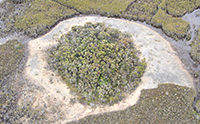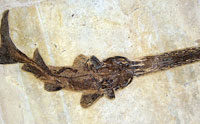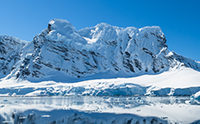Evolution relies on deep time which in turn relies on naturalism but science tells us the earth is young and so evolution is false. …read more Source: creation.com
Where in the geologic record is the Flood/post-Flood boundary? …read more Source: creation.com
Why unexpected fossil finds won’t falsify evolution. …read more Source: creation.com
When a bomb exploded right next to Samiha at St. Peter’s Church in Cairo on December 11, 2016, everyone thought she was dead. But Samiha miraculously survived—and now testifies of Jesus’ presence throughout her recovery. Samiha Tawfiq Awad and her husband Qalini prepared to go to church on one Sunday morning in December 2016. Qalini said he was tired, but Samiha encouraged him not to miss church. Once at St. Peter’s, the two parted ways. Qalini went to sit in the men’s section, and Samiha took her seat in the women’s section—an early church tradition still practiced by [More]
The geology of south-west Western Australia interpreted from a biblical perspective. …read more Source: creation.com
Scientists believed marine stromatolites were extinct—until they found them living in Shark Bay, Australia, in 1956. Living stromatolites keep popping up in more diverse environments. The latest research identified them even living on land. More… …read more Source: icr.org
Two recent articles in Nature Geoscience may provide important validations of the global Flood. Did researchers find evidence of the “fountains of the great deep” that started the deluge? More… …read more Source: icr.org
Millions of wooly mammoths once lived around the world, particularly in extremely cold places. These elephantine creatures present a major mystery for secular scientists. Why is that? How could wooly mammoths survive the frigid climate of an ice age? And where would they find a sufficient food supply? Read More: The Mystery of Wooly Mammoths | The Institute for Creation Research
Geologists reassessed the abundance of fossils in Earth’s uppermost rock layers this year, and they believe they found a remarkable sixth global extinction event. Their discovery has two significant implications. More… …read more Source: icr.org
Some are concerned that global warming will cause the polar ice caps to melt, leading to an increase in global sea level. If such a rise in sea level occurred slowly, coastal peoples would have time to adjust to the change. But many are concerned that sea level could rise rapidly, leading to a humanitarian catastrophe. Although some scientists claim that satellite and tide-gauge data confirm a rapidly rising sea level, others are skeptical. In fact, two Australian scientists, Dr. Albert Parker and Dr. Clifford Ollier, have recently charged that Indian Ocean sea-level data for the last 140 years [More]
The Institute for Creation Research has monitored the steady flow of fresh-looking fossils for over a decade. The year 2017 was impressive with its discoveries of biochemical variety that includes proteins, pigments, and even a pineal gland. Each such discovery presents a real challenge to the millions-of-years age assignments for these fossils, since best-case scenarios predict that biochemicals fizzle out in less than one million years. Read More: Best of 2017: Fleshy Fossils | The Institute for Creation Research
Research provides evidence that nuclear transmutation rates were dramatically higher in the past. …read more Source: creation.com
Extraordinary claims about this extraordinary creature don’t always match what the science is revealing. …read more Source: creation.com
Twelve criteria to use to define where the Flood stops in the rock record. …read more Source: creation.com
A team of scientists claims to have found the “oldest polar forest on record from the southern polar region.” The trees were found in Antarctica’s Transantarctic Mountains and include a mix of evergreens, deciduous trees, and gingkoes. How old is this oldest polar forest? More… …read more Source: icr.org
How an icon of secular geology provides powerful evidence for Noah’s Flood. …read more Source: creation.com
Abstract The Sauk megasequence is thought to have been deposited during one of the highest sea level episodes of the Phanerozoic. However, few, if any, have examined the extent and volume of sediments deposited across entire continents in order to test the published, secular sea level curve against the rock record. This study examines the Lower Paleozoic sedimentary rocks across North America, South America, and Africa with particular attention given to the Sauk megasequence. Results show that the Sauk megasequence most likely represented a limited rise in global sea level. Africa and South America exhibit very little evidence of [More]
I saw a story in the news recently that reminded me of the tentative nature of historical science (the kind of science that is not directly testable, observable, and repeatable because it deals with the past) and how frequently the evolutionary story changes. Many fossil bones have been discovered covered in cuts and scrapes. Researchers thought this demonstrated that our supposed human ancestors (really just ape species) used tools to get the meat off. But a new study says the marks on the bones may have been made by crocodiles instead! Read More: Did Hominids or Crocodiles Make Marks [More]
By Raymond Strom Size and roundness statistics were generated for 17 samples. The quartz and K-feldspar showed statistically significant rounding from the beach to the dune. …read more Source: AIG Daily
Geological forces could cause a devastating landslide. …read more Source: creation.com
A sack with petrified contents shows that millions of years is not needed for the process to take place. …read more Source: creation.com
PLOS ONE reported the recent discovery of a megatheropod—a large, two-legged dinosaur much like a T. rex—in Africa. What does this discovery tell us? More… …read more Source: icr.org
Unscrambling the clues at a fossil site in Argentina which contains thousands of yet-to-be-hatched dinosaurs that have been quickly buried. …read more Source: creation.com
Editor’s Note: First published in St. Louis MetroVoice 5, no. 2 (February 1995). The bitterest pill to swallow for any Christian who attempts to “make peace” with Darwin is the presumed animal ancestry of man. Even many Christians who uncritically accept evolutionary dogma as “God’s way of creating” try to elevate man and his origin above that of the beasts. Evolutionists attempt to soften the blow by assuring us that man didn’t exactly evolve from apes (tailless monkeys) but rather from ape-like creatures. This is mere semantics, as may be seen from the fact that many of the [More]
Editor’s Note: First published in St. Louis MetroVoice 5, no. 3 (March 1995). The evolutionist’s notion that man evolved by chance from ape-like creatures is largely based upon certain anatomical similarities between apes and men. Being convinced that such similarities “prove” an evolutionary relationship, paleoanthropologists have declared certain fossil apes to be particularly “manlike” and, thus, ancestral to man. Similarly, in an effort to fill the gap between apes and men, certain fossil men have been declared to be “apelike” and, thus, ancestral to at least “modern” man. You might say this latter effort seeks to make a “monkey” [More]
The results of an investigation into human footprints has brought conclusions that are out of step with evolutionary orthodoxy. …read more Source: creation.com
A catastrophic flood best explains the rapid depositional processes that formed a major geological feature in Central Australia. …read more Source: creation.com




































